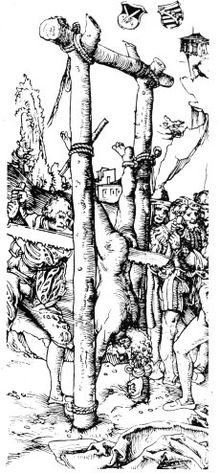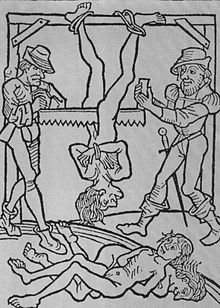- Death by sawing
-
The execution by sawing was a method of execution used in Europe under the Roman Empire, in the Middle East, and in parts of Asia.[citation needed] Some sources[who?] say that the method was probably never used[1]. The condemned were hung upside-down and sawn apart vertically through the middle, starting at the groin. Since the body was inverted, the brain received a continuous supply of blood despite severe bleeding, consciousness thereby continuing until, or after, the saw severed the major blood vessels of the abdomen.
A victim being sawn in two. (Drawing by Lucas Cranach the Elder)
Medieval China
The movement of the saw caused a body to sway back and forth making the process difficult for the executioners. The Chinese overcame this problem by securing the victim in an upright position between two boards firmly fixed between stakes driven deep into the ground. Two executioners, one at each end of the saw, would saw downwards through the stabilized boards and enclosed victim.[2]
Ancient Rome
Throughout the time of the Roman Empire this method of execution was uncommon. However, it was used extensively during the reign of Emperor Caligula[3] when the condemned, including members of his own family, were sawn across the torso rather than lengthways down the body. It is said that Caligula would watch such executions while he ate, stating that witnessing the suffering acted as an appetiser.[4]
References
- ^ Wolfgang Schild – Die Geschichte der Gerichtsbarkeit, München: Verlag Georg D. W. Callwey 1980. Lizenz für Nikol Verlagsgesellschaft mbH, Hamburg 1997 S. 44 ff.
- ^ Abbott, G. Execution: A Guide To The Ultimate Penalty, Summersdale Publishers Ltd, 2004. ISBN 184024433X
- ^ Suet. Calig. 27: multos [...] medios serra dissecuit - "He cut many people [...] in two with a saw"
- ^ Scott, G. R. A History Of Torture, Merchant Book Company Limited, 1995, p. 142. ISBN 1859581749
Categories:- Torture
- Execution methods
Wikimedia Foundation. 2010.


